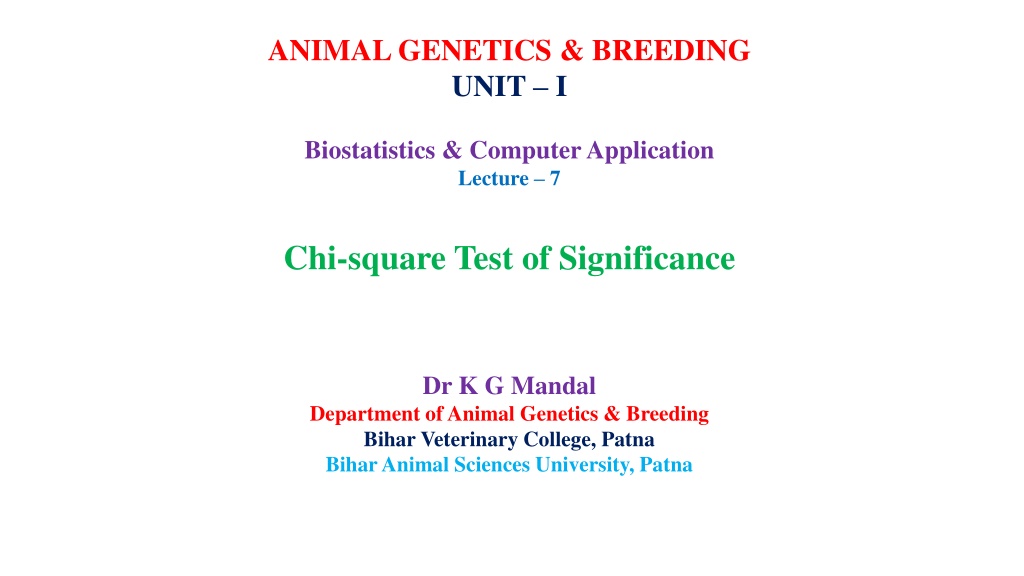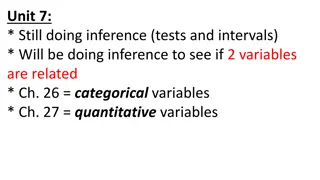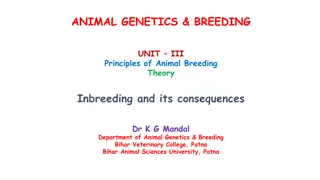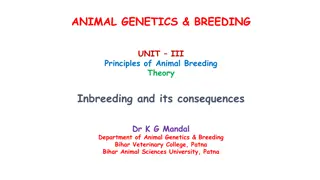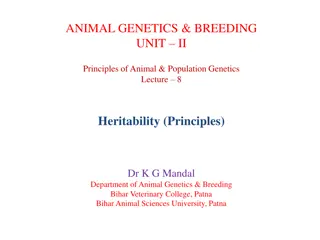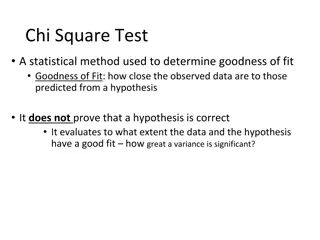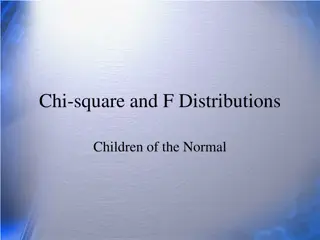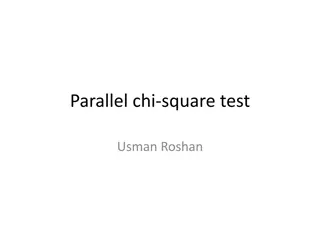Understanding Chi-Square Test of Significance in Animal Genetics and Breeding
Chi-square test of significance, designed by Karl Pearson in 1899, is widely used in animal genetics and breeding to analyze departures of observed frequencies from expected frequencies. This test helps in assessing goodness of fit, independency in contingency tables, homogeneity of variances, and detection of linkage in genetics. The test procedure involves forming hypotheses, calculating Chi-square, determining degrees of freedom, and comparing calculated and tabulated values to draw conclusions about the significance of differences between observed and expected frequencies.
Download Presentation

Please find below an Image/Link to download the presentation.
The content on the website is provided AS IS for your information and personal use only. It may not be sold, licensed, or shared on other websites without obtaining consent from the author. Download presentation by click this link. If you encounter any issues during the download, it is possible that the publisher has removed the file from their server.
E N D
Presentation Transcript
ANIMAL GENETICS & BREEDING UNIT I Biostatistics & Computer Application Lecture 7 Chi-square Test of Significance Dr K G Mandal Department of Animal Genetics & Breeding Bihar Veterinary College, Patna Bihar Animal Sciences University, Patna
Chi-square (2)test of significance Chi-square ( 2) test of significance was designed by Karl Pearson (1899). This test is applied to test the hypothesis when observations are expressed only in frequency. Chi-square is the sum of the ratio of square deviation or differences between observed and expected frequencies to the expected frequency. Ei E1 E2 Where, Oi = observed frequency in the ith cell Ei = Expected frequency in the corresponding cell i = 1,2,3, .n 2= Oi Ei2 = O1 E12 O2 E22 O3 E32 E3 On En2 En + + + +
It measures the departure of the observed frequencies from the expected frequencies. Level of significance: Generally 5% and 1% level of significance are used where there are risk of 5% and 1%. Level of significance is the level of possible error that we may commit in our conclusion or inferences in the testing of hypothesis. Use of X2 test: Chi-square test is used :- i.) to test the Goodness of fit ii) to test the Independency in contingency table iii) to test the Homogeneity of variances iv) Detection of linkage in genetics
Test procedure or steps involved : i) Formation of hypothesis i.e., HO & HA ii) Calculation of X2 iii)Deciding the degrees of freedom (df) iv)Tabulated value of X2 to be obtained from X2 distribution table for the corresponding degrees of freedom and level of significance.
v) Comparisons and conclusions : (a) If calculated value of X2 is greater than the tabulated value, the difference between observed and expected frequencies are significant. Therefore, null hypothesis may be rejected and alternate hypothesis may not be rejected. (b) If calculated value of X2 is not greater than the tabulated value of X2 for the corresponding degrees of freedom and level of significance, the difference between observed and expected frequencies are not significant. Therefore, null hypothesis may not be rejected and alternate hypothesis may be rejected.
Types of chi-square test: Following two chi-square tests are most commonly used. 1. Chi-square test of goodness of fit 2. Chi-square test of independency in contingency table (i) in 2x2 contingency table (ii) in rxc contingency table
1. Chi-square test of goodness of fit: This test is conducted when experimental observations fall under the influence of one factor or effect. E.g. sex ratio, blood groups, Mendelian classical phenotypic or genotypic ratios etc. Degrees of freedom (df) : In chi-square test of goodness of fit the df is N-1. Where N is the total number of class and 1 is the number of restriction imposed. Problem 1. Out of 250 calves born in a cattle farm of Sahiwal breed, 165 were females. Test whether these observations do agree with the concept of sex ratio to be 1:1.
Steps: (i) Formation of hypothesis: HO : Male and female births are in agreement with 1:1 ratio. HA : Male and female births are not in agreement with 1:1 sex ratio. (ii) Calculation of X2 : Particulars (a) Observed frequency(O) (b) Expected frequency (E) ( c) (O E) (d ) (O - E)2 ( e) ?1 ( f) X2 Male 165 125 40 1600 1600/125 1600/125 12.8 Female 85 125 -40 1600 Total 250 250 0 3200 ?1 ?12 12.8 25.6
(iii) Decision of d.f. and tabulated value of X2 : (a) As there are only 2 classes or levels of the effect of observations i.e., Male & Female, so there is only one independent class. Therefore, d.f. for X2 test will be 2-1 = 1. (b) Tabulated value of X2 distribution given for 1d.f. at 0.05 and 0.01 level of significance : At 0.05 level of significance = 3.84 At 0.01 level of significance = 6.63
(iv) Comparison and conclusion : (a)Since calculated value of X2 (25.6) for 1 d.f. is greater than the tabulated value both at 0.05 and 0.01 level of significance , so the differences between observed and expected frequencies are significant. (b)Therefore, HO may be rejected and HA may not be rejected. ( c)Hence, male and female births are not in the agreement of 1:1 sex ratio.
Exercise no. 1. Six hundred students were examined for their blood groups. Following results were observed. Test whether they fall under the ratio of 1:2:1. ( Given tabulated value of X2 for 2df at 0.05 = 4.74 and at 0.01 = 6.63). Particulars Blood Groups Total M MN N Observed Freq. 160 300 140 600
Exercise No. 2. In a breeding experiment following F2 populations were observed in four phenotypic classes. Determine how closely each of the following populations fits in the ratio of 9:3:3:1. (Given tabulated value of X2 for 2df at 0.05 = 4.74 and at 0.01 = 6.63). Sl.No. AB Ab aB ab 1. 315 108 101 32 2. 75 35 41 9
2. Chi-square test of independency in contingency table: This test is applied when the observations are made in the form of frequencies and not the sample estimates or population parameter like mean, variance or standard deviation. This test is applied when the observations fall under the effect of two major factors. This test gives the value of X2 with the assumption that the factors are independent. (a) Formation of hypothesis: HO : Factors are independent HA : They are not independent
(b) Presentation of data and calculation of expected frequency: Contingency tables are popularly known as rxc contingency table where r denotes the number of rows and c denotes the number of columns depending upon the number of levels under each factor. Following are the different types of contingency table: (i) 2 x 2 contingency table: with two major factors each having two levels or types. Presentation of data in 2 x 2 contingency table: Factor A Total Levels A1 A2 Factor B B1 a b a + b =R1 B2 c d c + d =R2 Total a + c =C1 b + d =C2 a+b+c+d = N Expected frequency of a,b,c & d cells is to be calculated. R1 + R2 = C1 + C2 = N
Expected frequency will be calculated in the following way: Expected freq. in cell A1B1 = in cell A1B2 =(c+d)(a+c) N ( c) Calculation of X2 = ? (d) Degrees of freedom for rxc contingency table = (r-1)(c-1) Where, r = number of rows & c = number of columns In 2 x 2 contingency table, the df = (2-1)(2-1) = 1x1 =1 (e) Comparison and conclusion : If calculated value of X2 is > tabulated value for the corresponding degrees of freedom and level of significance there is significant difference between observed and expected frequency. Hence, null hypothesis may be rejected and alternate hypothesis may not be rejected. (a+b)(a+c) N (a+b)(b+d) N R2C2 N , in cell A2B1 = (c+d)(b+d) N , in cell A2B2 = ? ?? =
If calculated value of X2 is > tabulated value for the corresponding degrees of freedom and level of significance there is significant difference between observed and expected frequency. Hence, null hypothesis may be rejected and alternate hypothesis may not be rejected. If calculated value of X2 is < tabulated value for the corresponding degrees of freedom and level of significance there is no significant difference between observed and expected frequency. Hence, null hypothesis may be accepted and alternate hypothesis may be rejected.
Problem 1. Out of two groups each with 15 animals, one group was vaccinated against a particular disease. 13 animals of vaccinated group and 7 animals of non-vaccinated group could survive after the vaccination. Test whether the vaccine was effective or not. Answer: (i) Formation of hypothesis: HO: Vaccination is independent of the incidence of disease or vaccine has no effect on the disease or vaccine is not effective. HA: Vaccination is not independent of the incidence of the disease or vaccine may be effective against the disease.
(ii) Presentation of data in 2x2 contingency table: Factor 1: vaccination Vaccinated group (A1) Non-vaccinated group (A2) Total Factor 2 Survived (B1) 13 7 20 Died (B2) 2 8 10 Total 15 15 30 (iii) Calculation of expected frequency in each cell: Expected frequency in A1B1 = 20x15/30 = 10 A2B1 = 20x15/30 = 10 A1B2 = 15x10/30 = 5 A2B2 = 15x10/30 = 5
1310 2 10 = 54 7 10 2 10 2 5 2 5 8 5 2 5 (iv) Calculation of X2for1df = = 9 (b) Without calculating expected frequencies: X2for 1df = 30 13?8 7?2 2 = 27 + + + 10 + 9 10 + 9 5 + 9 5 = 9+9+18+18 10 = 5.4 10 20?10?15?15 = 30 104 14 2 5 = 5.4 = 30?8100 45000 300?150 30 13 ? 8 7?2 30 22 (c) Yate s correction, X2 for 1df = = 30 90 15 2 45000 (v) Degrees of freedom is (r-1)(c- 1) = (2-1)(2-1) = 1x1 = 1 20?10?15?15 = 30 75 2 45000= 30?75?75 45000 = 3.75
(vi) Conclusion based on uncorrected X2 : (a) Since the calculated value of X2 is greater than tabulated value both at 0.05 and 0.01 level of significance, so the differences between observed and expected frequencies are significant. (b) So, Ho is rejected. (c) HA may not be true (d) Vaccine is highly effective (vii) Conclusion based on corrected X2: (a) Since the calculated value of X2 is not greater than the tabulated value at 0.05 level of significance, so differences between observed and expected frequencies are not significant. (b) Hence HO may not be rejected, HA may be true. (C) Vaccine is not significantly effective.
(ii) In 2x2 contingency table, chi-square may also be calculated without estimating the expected frequencies as follows: X2 = (a+b)(c+d)(a+c)(b+d) (d) Yates correction: Yates correction is required for 2x2 contingency table if frequency in any cell is 5 or less than 5. Under this situation the corrected chi-square, N ad bc N 2 (a+b)(c+d)(a+c)(b+d) (e) Comparison and conclusions are made in the same way as done for Chi-square test of Goodness of Fit. N ad bc2 2 X2 =
(iii) Presentation of data in 3 x 3 contingency table when number of levels under each factor is three : Factor A Total Levels A1 A2 A3 Factor B B1 A b c a +b + c = R1 B2 d e f d +e + f = R2 B3 g h i g + h + I = R3 Total a + d + g = C1 b + e + h = C2 c + f + i = C3 N Where, a, b, c, d, e, f, g, h & i are observed frequency in the respective cell. Expected freq. in cell A1B1 = R1xC1 In cell A3B1 = R1xC3 N R1 + R2 + R3 = C1 + C2 + C3 = N , in cell A2B1 = R1xC2 N N . In cell A3B3 = R3xC3 N
?? ??? ?? Calculation of X2= DF in 3x3 contingency table =(3-1)(3-1) = 2x2 = 4 Tabulated value of X2 at 4df & 5% LS = at4df & 1% LS = Comparison and conclusion: i) If calculated value of X2 is > tabulated value for the corresponding degrees of freedom and level of significance there is significant difference between observed and expected frequency. Hence, null hypothesis may be rejected and alternate hypothesis may not be rejected. ii) If calculated value of X2is < tabulated value ..
Problem 2. Three different breeds of goats were observed for their body colours. Following results were obtained: Breeds Total B1 B2 B3 Body colour White 80 150 70 300 Black 100 240 160 500 Grey 70 60 70 200 Total 250 450 300 1000 Test whether breeds differ significantly in colours. Given tabulated value of X2 for 4df at 5% LS = 9.48 1% LS = 13.27
